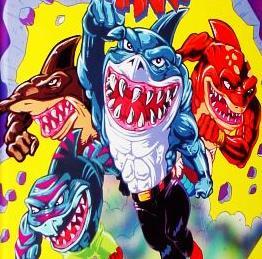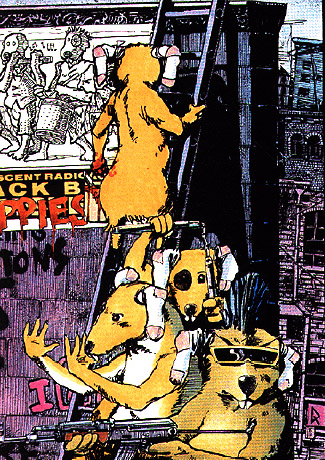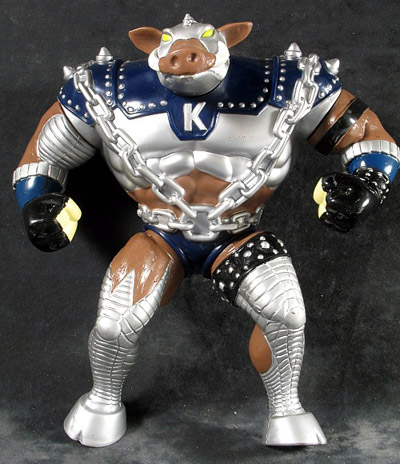The 9 Least Terrible Teenage Mutant Ninja Turtles Rip-Offs
 By Todd Ciolek
By Todd Ciolek
We?ve all heard the tale of how Teenage Mutant Ninja Turtles went from a parody comic to a monstrous devourer of pop-culture worlds. By the time the ?90s arrived, the Ninja Turtles presided over cartoons, movies, bath towels, stationery, pudding pies, video games, pizza, and action figures that ate up half an aisle at Toys R Us. It was a merchandising empire of the scale seen only once or twice a decade, and countless toy companies and cartoon studios, driven by the same me-too mindset as the impulsive kids they sought to exploit, wanted their own versions of the Turtles.
You can?t blame them. After all, the Turtles seemed so easy to emulate: just take some disfigured animal characters, infuse them with kid-friendly attitude, apply some semi-ironic names, give them a human woman to constantly rescue, and throw in some self-aware mockery so that parents wouldn?t completely hate the show. Yet it was tough to actually pull off, especially when kids everywhere already had Leonardo, Raphael, Michelangelo, and the Smart Turtle who Sounded Like the Quik Bunny. That didn?t stop animators, comic authors, and toy makers from trying, and their regurgitated creations clogged early-morning TV schedules and discount bins throughout an entire decade. Some were better than others, but all of them deserve credit for teaching a young generation to spot the derivative by-products of a pop-culture titan.
9) Stone Protectors
Catchphrase: ?Trolls on a roll!?
This decade has so far evaded a resurgence of the troll doll, the rubbery, high-haired little figures that have haunted American toy lines and co-worker desks for decades. Their last major incursion was in the mid-1990s, when troll dolls took over all sorts of venues, despite looking like some cheap trinket that should, by all rights, be gathering dust at a souvenir stand outside some Belgian cathedral. Troll dolls became t-shirts, candy, computer games, and even inspired an actual Teenage Mutant Ninja Turtles line of troll dolls.
Yet there was a problem. Popular as the troll dolls were with girls and office workers, they just weren?t making in-roads with the violent-little-boy market. Hasbro tried Battle Trolls in 1993, but they were just troll dolls with scarier faces, and no amount of aggressive commercials could override that. Ace Novelty had a better idea: the trolls needed to be redesigned, renamed, and promoted with a cartoon.
We?ll give Stone Protectors a little credit. It?s pretty much a shameless repetition of everything kids might?ve liked in the Ninja Turtles (skating! swords! wrestling!), but there?s at least a vaguely Scottish guy to go along with the cocky one and the one who talks just like Michelangelo. Of course, any unique ideas are undone when the Stone Protectors sing about their foibles and abilities in a righteously radical rock number that would?ve been embarrassing even back when Loverboy had radio hits. The Turtles didn?t need to sing about themselves. They had a wailing, generic-voiced guy to do that for them.
8) Extreme Dinosaurs
Catchphrase: ?Let?s fossilize ?em!?
At first, it?s hard to tell if Extreme Dinosaurs is yet another take on the Ninja Turtle phenomenon or a parody invented by bitter writers and producers who?d had to make one mutant-animal cartoon too many. The fact that it began in 1997 as an off-shoot of Street Sharks (under the name Dino Vengers) suggests that it?s yet another cash-in, but there?s something self-assuredly ridiculous about the opening episode, in which an evil, time-traveling, blue-skinned space elf sucks up a grab bag of dinosaurs. Transformed into muscle-bound dino-mutants, the newly extreme creatures instantly adapt to their stereotypes, spout quip-laden dialogue, and accept their roles as noble protectors who are totally ready to rumble anytime. Then a buzzcut-sporting space-elf woman nags them.
As the show continues, the intent becomes a little clearer: Extreme Dinosaurs is merely one of the later Ninja Turtle clones, distanced somewhat by the influences of Jurassic Park and Surge commercials. Perhaps it would stand apart if it offered the pretense of teaching kids about dinosaurs with all the preachy convenience of a G.I. Joe PSA, but?.nah. Sure, there?s some pseudo-science amid the space-elf nonsense, and its clearest Turtles clone is a resident smart-guy like Donatello. And yet we imagine that most dinosaur-loving kids would?ve written off show after seeing a Stegosaurus in the group, as that species would?ve been extinct by the time T-rexes and Triceratops were around.
7) The Cheetahmen
Catchphrase: ?Livin? large!?
The story of the Cheetahmen is forever tied to that the Action 52, an unlicensed NES and Sega Genesis game created by Action Enterprises in 1993. As the sales pitch liked to tell it, the Action 52 was a groundbreaking alternative to other NES titles. Why? Because the Action 52 packed 52 different games in one cartridge. Of course, the Action 52 ran $200 and all of the games were terrible, but revolution is seldom without cost.
Action Enterprises had big dreams for the Action 52 and the stars of its most prominent game, The Cheetahmen. A Cheetahmen comic book was packed in with the pricey 52-in-one game, and it detailed the origins of three cat-men. Draw with all the artistry of that guy from your high-school art class who really liked Rob Liefeld, the comic begins with the mad Dr. Morbius gunning down a mother cheetah and claiming her three cubs for his experiments. The little cheetahs become grown animal-people with boring weapons and classical names: Aries, Hercules, and Apollo. By the third page, they?ve rebelled against their creator and his other beast-men, all based on less cuddly African creatures. Their story concludes with an uncertain glimpse of their future battles with Morbius and crude illustrations of the Cheetahmen action figures, about which fans were commanded to ask their local toy stores. Feel free to read it here. The game itself made one addition: a Captain N clone who?s sucked into the Cheetahmen game itself.
Action Enterprises didn?t stop there. A sales brochure promises a one-minute Cheetahmen cartoon with ?Disney? (their quotation marks, not ours) quality animation and a Cheetahmen promotional outfit controlled by ?servos,? all designed to make three bland cat-warriors ?the most desired and merchandises items for Christmas 93?[sic].?
There were no toys, syndicated TV shows, or underpaid interns wandering around in hideous Cheetahmen suits with ?servos.? Action Enterprises and their Bahamas-based finances exited the game industry with astounding speed, and no one expected to see the Cheetahmen again. It wasn?t until the late ?90s that a canceled Cheetahmen II Nintendo game surfaced, and fans of hideous old games championed it a bug-filled mess with strangely compelling music. Such is the Cheetahmen legacy.
6) Adolescent Radioactive Black Belt Hamsters
Catchphrase: ?Ho! Hamsters!?
The Ninja Turtles may have inspired a host of copycat toy lines and cartoons, but it was nothing compared to what exploded in the small-press comic market. The Turtles were a parody of superhero trends in the early 1980s, but they were fair game once they became a trend themselves, inspiring the largest outpouring of parody-of-a-parody series ever seen. The world of black-and-white comics soon saw the Cold-Blooded Chameleon Commandos, The Post-Atomic Cyborg Gerbils, Komodo and the Defiants, the Hard Rockin? Rabbits, and the Pre-Teen Dirty Gene Kung-Fu Kangaroos, the last of which even brought aboard TMNT co-creator Peter Laird. Most of them were terrible.

The most accomplished of these were the Adolescent Radioactive Black Hamsters. Written by Don Chin and illustrated by The Maxx creator Sam Kieth and Parsonavich in 1986, the series shoots four hamsters into space, where they?re mutated by eerie space Jello. Arriving back home, they are trained by a cadre of monks and given appropriate names: Clint, Chuck, Jackie, and Bruce. The series lasted nine issues and , which was a good eight issues longer than the usual TMNT knock-off.
It was, sadly, ahead of the game. By the time the comics ended in 1989, the Turtles were just beginning to dominate after-school cartoons, and it was too early for an ARBBH show. There?s now a remake (starring new hamsters with names like Jean Claude and Lucy) of the comic on shelves, but we somehow doubt it?ll become a TV series and market-eating toy line. And perhaps that suits its indie roots.
5) The Immature Radioactive Samurai Slugs
Catchphrase: ?It?s time to slime!?
Tiny Toons is lauded for dragging kids? cartoons out of the rancid depths of toy-shilling in the 1990s, yet such praise glosses over the show?s occasionally limp attempts at recapturing the spirits of Looney Tunes in self-mocking form. Tiny Toons had its moments, of course, and one of them took aim at the biggest name in kids? toys and cartoons, circa 1991.
It?s not just the Ninja Turtles? theme song that?s mocked. The overenthusiastic Plucky Duck is revealed as an unwitting pawn of the Immature Radioactive Samurai Slugs? merchandising arm, buying posters, toys, hats, and a watch that does absolutely nothing. He and Hampton even make their own Slugs costumes, complete with the sneering grin that all TMNT-branded figures bore. They?re soon pursued by the Iodizer, the arch-nemesis of the Slugs. The joke wears thin by the end of the episode, which sees the Iodizer run off by elf in search of a salt lick, while Hampton delivers the self-consciously lame moral: ?Just say no to slugs.? This would all seem an incisive lesson for kids if Tiny Toons toys, video games, and similarly branded products weren?t showing up in stores at the same time.
—-
4) Cy-Boars
Catchphrase: ?This ain?t the Three Little Pigs!?
By the mid-1990s, the Ninja Turtle fad was at its end. Kids had watched the TV show and bought gimmicky action figures for nearly a decade, but the franchise sputtered out somewhere around robot-piloting Leonardo and falafel-making Donatello. This also marked the end of many hangers-on, as studios turned to profiting from their own versions of Power Rangers or Dragon Flyz. For Vintage Comics and a toy company called Imaginary Limitz, however, 1996 was ripe to seize the reins of the Turtles? dwindling empire with a new breed of animal-themed heroes: the Cy-Boars.

If there were pitches for a Cy-Boars cartoon, they didn?t convince anyone. Instead, the market got a line of Cy-Boars action figures and a comic series that, based on all available evidence, lasted one issue. The creative forces behind this porcine toy line knew that the territory they were entering was a bit clich?d. For starters, every TMNT rip-off had its heroes either descending from space or gestating from some mutating experiment. So Cyboars mixed the two: the boar-men are originally from another planet, but after crashing to Earth, they?re turned into cybernetic killing machines by a secret organization. No, that certainly isn?t the Three Little Pigs. You?ve got us there.
The comic was quickly swept aside, though the Cy-Boars toys had slightly more of a presence, as a single peg in Wal-Mart?s toy department offers greater exposure than the dollar box at a comic store. With names like Bush Hog, Hog Kong, Chop Suey, and Stampede, the figures might?ve made half-decent stand-ins for Bebop in a kid?s Ninja Turtles collection, as they were big, unappealing pig-things generic enough to fit in just about anywhere. And that?s why they ultimately went nowhere.
3) Street Sharks
Catchphrase: ?Jawsome!? (variant spelling: ?Jawesome.?)
The Street Sharks occupy a small, seldom-examined place in the collective unconscious of those who grew up in 1990s. These now-grown kids have all forgotten watching the Street Sharks cartoon or playing with the toys in 1993, but merely uttering the word ?jawsome? will make all of those memories surface like a giant, top-heavy man-shark wearing jeans.
Perhaps inspired by the abortive Battletoads pilot, the Street Sharks series reverses the idea behind the turtles: instead of sea predators becoming humanoid, the four young sons of a noble scientist are transformed into hulked-out shark men. Their father is mutated off-camera by his unscrupulous bald mentor (who looks like a duller version of Golobulus from the G.I. Joe movie), who immediately invites his children to become experiments, a fate they rush toward by parachuting and skateboarding and rollerblading and other completely mondo modes of totally tubular transportation. Yet they soon became Street Sharks, found allies in their father?s overworked colleague and her laid-back assistant (who filled the Michelangelo-clone quota), and, well, beat up other mutants without ripping their pants.
Curiously, the Street Sharks never inspired a videogame in their three years on the market, even though every cartoon character from EXO Squad to Izzy the Olympic Mascot did. Being jawsome will only take you so far.
2) Biker Mice from Mars
Catchphrase: ?Rock and ride!?
As Ninja Turtle lore had it, the four teenage mutants were transformed into humanoids by experimental ooze, and the cartoons and toy line drove that idea until the engine exploded. As the franchise evolved, turtles and rats weren?t the only ones who could be changed into anthropomorphic hybrid action figures. Frogs, alligators, ducks, manta rays, flatworms, lizards, geckos, bulls, flies, and just about anything else could become an animal-human, to the point where they got a spin-off comic (and cartoon pitch) called The Might Mutanimals.
Yet the Ninja Turtles never created intergalactic mouse-man bikers, and this vital niche wasn?t filled until 1993, when Rick Ungar, fresh off the success of an X-Men cartoon that didn?t require 15,000 issues of setup to understand, launched Biker Mice from Mars. In the first episode, three super-macho joyriding vermin named Throttle (the leader, played by Rob ?Raphael is Cool But Rude? Paulsen), Vinnie (the cocky one) and Modo (the boring one) waste very little of the viewer?s time. By the ten-minute mark, they?ve arrived on earth, beaten up some human criminals, saved their skeptical human-woman sidekick, and pelted kids with off-timed jokes about Grey Poupon and The Duke of Earl. There?s even a stab at a certain hot property when the most deadpan of the three mice asks ?You were expecting Turtles, maybe??
Yes, we were. Between the beefy rodents and the constant quips, Biker Mice could easily be mistaken for an episode of TMNT. An episode that?s trying a little too hard. The rapid-fire humor is mostly painful, and the opposition consists of polluters and their stupid henchmen overrunning the Martian mice, in a setup that worked better in Bucky O?Hare. Not that Biker Mice was a failure. It spawned video games and reached that coveted 65-episode mark, ensuring a healthy syndicated life off dulling imaginations everywhere. It even earned that most revered of cheap cartoon honors: a remake. A new version of Biker Mice from Mars is now airing, and we hear there?s an utterly savage and timely parody of Donald Trump.
1) Battletoads
Catchphrase (videogame): ?Mad, bad, and crazy toads!?
Catchphrase (cartoon): ?Let?s get warty!? (frequently misheard as ?Let?s get horny!?)
Most of the franchises that joined the mutant-animal-hero fad made the tactical mistake of fighting the Ninja Turtles on their home turf: the closely linked worlds of cartoons and toy lines. The marketers behind Battletoads were too smart for that. They targeted the Turtles where they were weakest: videogames.
Not that there weren?t a few excellent Ninja Turtles games out there, but it?s likely that Rare took a look at the thrown-together first TMNT game for the NES and decided that they could do it better. The better Ninja Turtles games were beat-?em-ups with somewhat repetitive play, so the 1991 Battletoads game made each of its stages different: a fall through a bird-filled cavern, a surfboard obstacle course, a chase across speedy mechanical snakes, and a frustrating exercise in guiding a speeder-bike past stone barriers.
Battletoads came out swinging in its print ads, which put forth the theory that turtles were ?pond scum? compared to the heroic toad-men known as Zitz, Rash, and Pimple. Battletoads even had a cartoon-ready backstory: with a style somewhere between 1950s pulp comics and catchphrase-spouting ?90s annoyances, the three toads were three game players (later changed to be three teenage losers from Oxnard, California) who became superhero amphibians, met up with a vulture scientist, and rescued a princess named Angelica from the Dark Queen, who was more or less a sultrier-dressed version of Morticia Addams..
But it wasn?t enough for the Battletoads to have a decent game. They were supposed to be the Next Big Thing, as shown by unearthed design documents for Battletoads candy, Battletoads toys, Battletoads Halloween costumes, and Battletoads ?his and her? aprons depicting the scaly abs of a Battletoad and the wasp-waisted torso of the Dark Queen. Yet none of these could be made until there was a Battletoads cartoon to promote it.
So Battletoads got a cartoon. One cartoon. The keepers of Battletoads and the animators at DIC were clearly aiming for Ninja Turtles territory, even going so far as to hire writer David Wise, one of the key architects of the TMNT cartoon, to script a pilot episode for Battletoads. And so, on one day in 1992, Fox aired this:
Unsurprisingly, there was to be no TV series for Battletoads. Today, the three would-be Ninja Turtle successors and their acne-derived names are remembered mostly for their first NES game?and how everyone hated the speeder-bike level.

